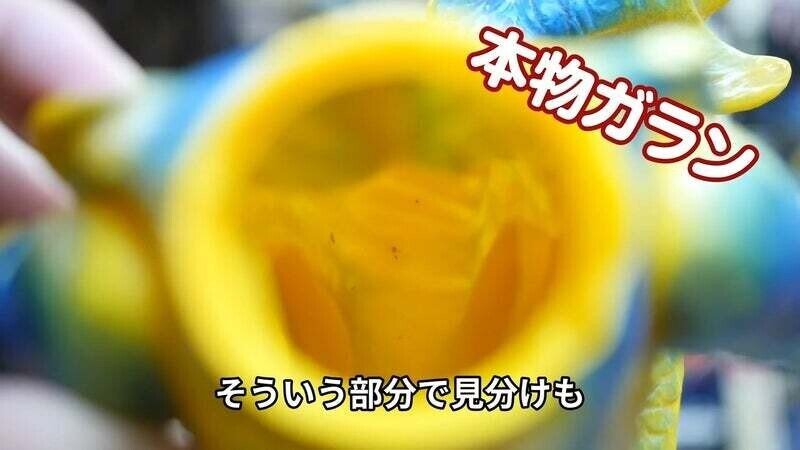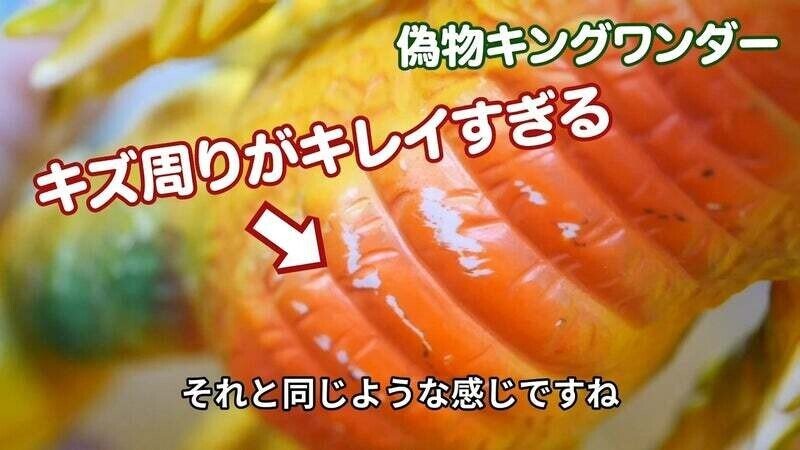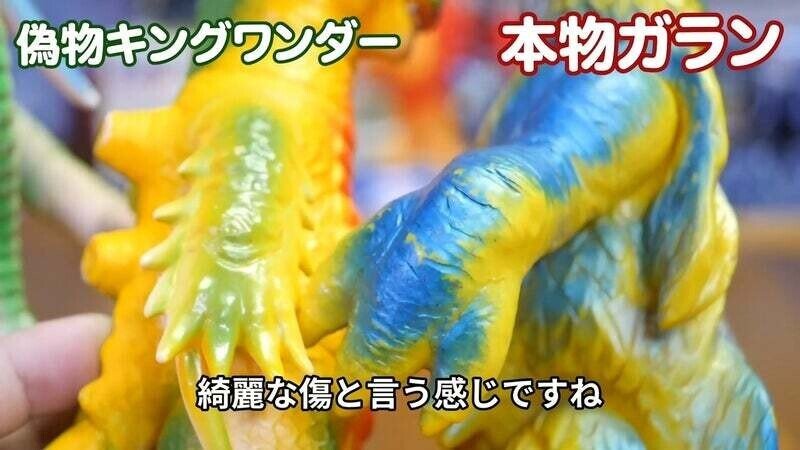
[1: SOFUBI at that time] The point to distinguish between genuine and fake! Showa retro is deep with "smell", "scratch", "thickness" and so on.
This time, I would like to talk about SOFUBI in two parts. In the first
installment, I would like to look at the real and fake SOFUBI and talk about
the points to identify the fake. In the second installment, I think that it is
a world view unique to SOFUBI, but I would like to talk about the definitions
of fake and "pachimono" (forged stuff), including our own personal views.
This time it's a SOFUBI doll, but it's very difficult. I would like to summarize the difficulty and complexity as easily as possible.
The main points to compare between the original and the fake this time are:
1, Smell 2, Scratches 3, Thickness and weight
I would like to focus on these three and compare them for verification.
The subject of this time is, first of all, the real thing at that time was
Bullmark's "Garan"! And here are three fakes to compare with that "Garan"! It
will be "Taigan", "King Wonder", and "Big Eye". I couldn't get the same thing,
but there are some elements to compare between the original and the fake, so I'd like to compare them.
(**From right: Garan, Taigan, King Wonder, Big Eye**)

So let's start with
1. Smell
First, prepare a paper bag and a hair dryer to compare and verify the smells.
We are going to warm it up and disassemble it, trap the scent and sniff out the difference in the scent.
The real scent of that time = the strong scent of petroleum.
Existent SOFUBI, current product, has a strong vinyl smell.
And the smell of the 3 fake figures = like a mixture of petroleum and vinyl.
This is just a guess, but I think that, the SOFUBI that's currently made, was
boiled in oil to give it a petroleum smell. I think the boiling was too weak, so
the smell is a mixture of oil and vinyl. And it doesn't have a strong vinyl
smell like the recent reissues, and the smell itself is faint. This is probably
also the case, but I think that the scent that was boiled in oil to resemble the
thing at that time became thinner over time.
If you really want to make a fake, you have to boil it in the oil longer to get
the oil to penetrate completely, so the oil smell is weaker.
This is also one of the judgement points, but if you boil it more, the smell of
petroleum will be strong, so it may be difficult to distinguish by "smell only"
in some cases.
In any case, the 3 figures are fake, when the head is removed and warmed up and there is no strong smell (of oil) like the one at that time.
Points
→When warmed up, the SOFUBI will soften, so you can actually take the parts off to see what's inside. If the SOFUBI of that time is old, it is almost 60 years
from 1966 (the year when Marusan started production), so mold grows inside, and if it is used to some extent, mud and dirt will be attached to the joints or
even cracks.

*Authentic "Garan". ↑*
Most of the forgery is made to resemble the "appearance", so the inside is
basically clean.
The smell of the Showa era has a soft, nostalgic scent. On the other hand, the
fake stuff are full of the nasty, chemical smell to it.
2. Scratches
It's quite important here!
All 3 have such scratches. However, when you look closely, it is quite unnatural. Even though there is a big color baldness as a scratch, the area around the big color baldness is beautiful. All 3 have noticeable color baldness, but the other paints themselves remain clean.
Regarding "King Wonder", there is a color transfer of the black line, but the
colors are all the same. Whether it's a scratch or a black color shift, it's
very likely that they've deliberately added it. It means that there is an
unnaturalness that seems to have been added intentionally.

*Fake "King Wonder". Around the scratches are too clean. ↑*
Points
→It feels like it's been scratched cleanly.
It's like the difference between a pair of jeans that have been worn naturally
and have torn knees and those made with damage processing...
And if you take it apart and look at what's inside, which I talked about
earlier, you'll see that even if it's intentionally soiled, you'll feel
uncomfortable.

↑ Fake "King Wonder" Authentic "Garan" ↑
3. Thickness
Most of Bullmark's SOFUBI figures in the latter half are thin, but these 3 fake
figures are thick and heavy. The normal SOFUBI weights about 130g, but the
"Taigan" weights 195g.
Fake "Taigan": 195g
Fake "King Wonder": 149g
Fake "Big Eye": 174g
Real "Garan": 146g
By the way, I think it will be a matter of color, but basically the color is
individually different, so it doesn't matter much.
At that time, the mass production of toys was really random, and there were many individual differences because sometimes, the part-time housewife painted and assembled while carrying a baby on her back. Moreover, if the paint runs out before the quota of the day is achieved, they painted in a different color and delivered it.
There is a story that it will be a super premiere as a rare color 30 years later.
So, it seems difficult to judge by color.
However, the color of this "Garan" is a color that has passed over the years,
and the other 3 fakes do not feel the "taste" of aging. Although, this is
entirely a feeling...
At that time, many subcontractors were involved in the production of these
pieces, so it is only natural that there would be individual variations in color.
It would be easier if we had a real one to compare with, but the forgeries are
made from molds of the real ones, so they are a size smaller. If you heat it up with a hairdryer and put the limb parts of the forgery on the main body, it will be very loose.
The real ones from that time are super rare, but there are quite a few people
who collect fakes (forgeries), thinking they are real, so there is a good chance
that the person who has it also bought it thinking it was real and collected it.
So I hope this will be of some help to you.
Some of the pieces are taken from the real "mold", so many of them are very
difficult to judge.
The 3 figures we have told you about are obvious forgery because they have
malicious and deliberate scratches. There is really a lot to learn about SOFUBI.
And it's also interesting because it's deep and has deep-rooted fans.
That is "fakes" and "forged".
This sense of values regarding "fake" and " forged" is also an indispensable
story when talking about the world view of SOFUBI. So I would like to talk about "forged stuff" in the next blog.
Summary
1. Smell
ーーーーーーーーーーーーーーーーーーーーーーーーーーーーーーーーーー
Genuine: The smell of things at that time = the strong smell of oil, the smell
of Showa era. Genuine: Current smell = vinyl scent.
Fake: The Smell of things at that time = oil and vinyl mixed together. Boil with
petroleum. When you boil them longer, some of it smells like it was made in
those days.
Fake: Current product smell = vinyl scent.
ーーーーーーーーーーーーーーーーーーーーーーーーーーーーーーーーーー
2. Scratches
ーーーーーーーーーーーーーーーーーーーーーーーーーーーーーーーーーー
It is important to note that these items are of a certain age and have natural
scratches. The fake one has scratches that look as if they have been deliberately inflicted with a blade.
(The area around the scratch is relatively clean) It's unnatural.
ーーーーーーーーーーーーーーーーーーーーーーーーーーーーーーーーーー
It's like that.
In the next SOFUBI verification, I would like to talk about "fake" and "forged
stuff".
[Toy's King Retro Museum!} Retro Toys for Sale on Instagram!
この記事が気に入ったらサポートをしてみませんか?
